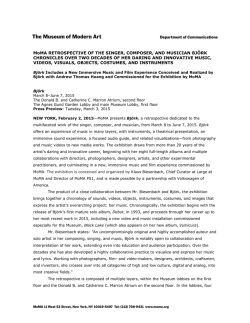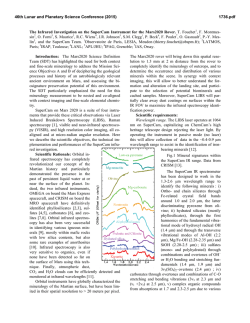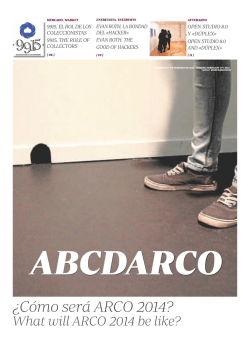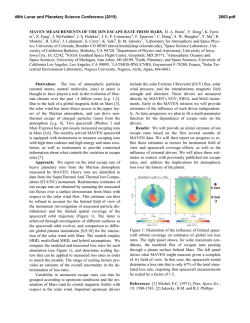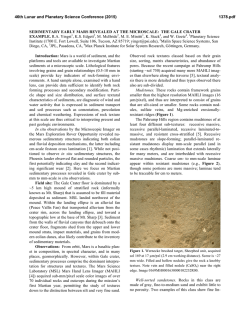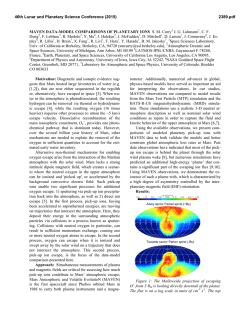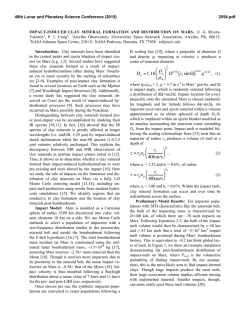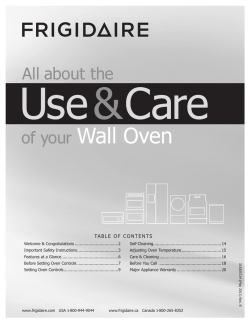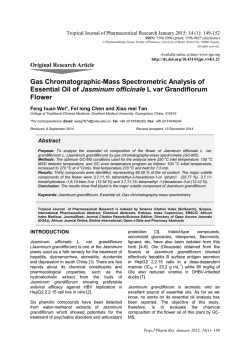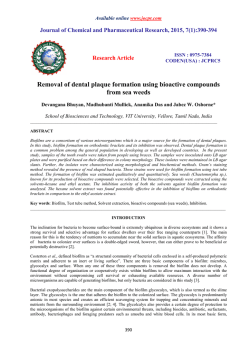
MOMA Gas Chromatograph-Mass Spectrometer onboard the 2018
46th Lunar and Planetary Science Conference (2015) 2680.pdf MOMA Gas Chromatograph-Mass Spectrometer onboard the 2018 ExoMars Mission: prototype results and performance A. Buch2,V. T. Pinnick2, C. Szopa3, N. Grand4, O. Humeau3, F. H. W. van Amerom5, R. M. Danell6, R. Arevalo2, P. Coll4, W. B. Brinckerhoff2, P. R. Mahaffy2, F. Raulin4, F. Goesmann7, and the MOMA Team1-7, (1) NASA Goddard Space Flight Center, USA ([email protected]), (2) LPGM, Ecole Centrale Paris, Châtenay-Malabry, France, (3) LISA, Univ. Paris Est Créteil & Paris Diderot, CNRS, Créteil, France (4) LATMOS, Univ. Pierre et Marie Curie, Univ. Versailles Saint-Quentin & CNRS, Paris, France (5) MiniMass Consulting, USA, (6) Danell Consulting, USA, (6) Max Planck Institut für Sonnensystemforschung, Germany Introduction: The Mars Organic Molecule Analyzer (MOMA) is a dual ion source linear ion trap mass spectrometer that was designed for the 2018 joint ESARoscosmos mission to Mars. The main scientific aim of the mission is to search for signs of extant or extinct life in the near subsurface of Mars by acquiring samples from as deep as 2 m below the surface. MOMA will be a key analytical tool in providing chemical (molecular and chiral) information from the solid samples, with particular focus on the characterization of organic content. The MOMA instrument, itself, is a joint venture for NASA and ESA to develop a mass spectrometer capable of analyzing samples from pyrolysis/chemical derivatization gas chromatography (GC) as well as ambient pressure laser desorption ionization (LDI). The combination of the two analytical techniques allows for the chemical characterization of a broad range of compounds, including volatile and non-volatile species. Generally, MOMA can provide information on elemental and molecular makeup, polarity, chirality and isotopic patterns of analyte species. Here we report on the current performance of the MOMA prototype instruments, specifically the demonstration of the gas chromatography-mass spectrometry (GC-MS) mode of operation. The MOMA GC-MS Instrument Suite: The MOMA GC-MS instrument consists of three main components, lead by three international hardware development teams. The martian regolith samples will be deposited into an oven (Figure 1a) and sealed using a tapping station developed by colleagues at the PI institution (Max Planck Institut für Sonnensystemforschung, Germany). The gas chromatograph design, being matured by teams at LATMOS, ECP and LISA in France, consists of an internal He reservoir, 2 hydrocarbon injection traps, 4 chromatography colums, each equipped with a thermal conductivity nanodetector (nanoTCD). The MOMA mass spectrometer (developed at NASAGSFC, USA) consists of a linear ion trap with 2 reduntant filaments for electron impact ionization and 2 redundant channel electron multiplier detectors. The ion trap is modeled after the 4X larger trapping volume Thermo LXQ [1]. Until recently, most of the GC-MS performance testing occurred using the brassboard GC (Figure 1b) and the prototype mass spectrometer. However, some initial testing using the advanced prototype GC (Figure 1c) with the same prototype mass spectrometer has demonstrated basic functionality of the GC-MS interface with higher flight fidelity. Fig. 1. (a) MOMA prototype oven. (b) Single column MOMA brassboard gas chromatograph. (c) Fullup MOMA advanced prototype model gas chromatograph. (d) MOMA mass spectrometer with EI source. Performance Testing: Brassboards of the individual MOMA instrument components (sample oven, GC and MS) were developed and their performances tested independently. Interface tests are therefore critical to provide insight into the end-to-end GC-MS performance of the MOMA instrument. Both brassboard and prototype GCs were connected to the prototype MS in flight-like configurations (Figure 2). Volatiles can be directed into the MS for calibration and sensitivity measurements either by a directly plumbed line or through volatilization of liquid or solid phase analogs from the sample oven. Solid samples were doped with various organic compounds and extracted by pyrolysis. Analytes were then separated with an MXT-5 chromatographic 46th Lunar and Planetary Science Conference (2015) column (30m, 0.25mm, 0.25 µm, Restek) and analyzed by a thermal conductivity detector followed by the linear ion trap MS. 2680.pdf tate, hexane, benzene, toluene, dodecane, fluoronaphtalene, heptanol, pentanol, dimethylformamide (DMF) diluted in methanol and deposited onto silica beads in the MOMA oven (figure 4). During the first iteration of testing, transfer lines were not completely heated (i.e. cold spots were present), thus the potential for condensation after TCD but before MS detection is high. However, the MS was found to be 5-10 times more sensitive than the GC-TCD for hexane and benzene respectively with an ultimate sensitivity of ~1-10 pmol. Fig. 2. Laboratory configuration for GC-MS interface testing with single column GC, split manfold with exhaust at mars pressure (bottom chamber of MS vacuum housing) and mass spectrometer (top chamber of MS vacuum housing). Initial testing of the end-to-end GC-MS MOMA instrument involved the injection of a 1000 ppm gas phase mixture of butane, pentane, hexane and benzene in bulk helium. An overlay of the MS and TCD signals showed (figure 3) a similar response in terms of separation efficiency and peak shape, confirming that the interface between the GC and LIT introduces minimal dispersion. Key operational parameters such as column temperature and separation efficiency were determined. Figure 4: GC-MS analysis of the liquid mixture containing 5µL of phenylethanol, 1-butanol, methyl-acetate, hexane, benzene, toluene, dodecane, fluoronaphtalene, heptanol, pentanol, dimethylformamide (DMF) diluted in 100µL of pure methanol. Additional experiments investigating solid soil samples pyrolyzed in the brassboard oven are currently underway in order to investigate system performance with higher fidelity samples similar to what would be expected on Mars. Results from this testing, demonstrating MOMA’s ability to extract and detect trace organics via in situ derivatization are currently being planned. References: [1] Schwartz J. C. et al. (2002) J Am. Soc. Mass Spectrom. 13, 659–669. Figure 3: Separation of 10µL gas mixture of butane, pentane, hexane and benzene in He (1000 ppm) The end-to-end sensitivity of the GC-MS interface depends heavily on the ionization efficiency of the analyte, the quality of the thermal control along the sample path, and the split manifold design. The MOMA requirement for sensitivity for organics in GC-MS mode is 1 pmol injected into the sample oven. Sensitivity was determined for the GC-TCD and MS response to a dilution series containing phenylethanol, 1-butanol, methyl-ace- Acknowledgement: The support by DLR (FKZ 50QX1001) is gratefully acknowledged. The development of MOMA-MS is supported by the Mars Exploration Program (HQ Program Executive: Lisa May). The development of MOMA-GC is supported by the French Space Agency, CNES, gratefully acknowledged.
© Copyright 2025
